Coral Island is a game that has generated a ton of excitement in the farm-sim and cozy game communities, and so far it has certainly lived up to the hype. This is a game that might be the first one to give Stardew Valley a serious run at its own style and game – and that’s exciting for those of us who love the genre.
Coral Island is a game that has really backed up that promise and delivered a stunning game – and one that has you jumping right in learn a whole lot of mechanics from day one. Some of these will be familiar to players of past Harvest Moon (Story of Seasons) games or Stardew valley, but some are quite new or have their own twist on it.
Discovery is part of the fun, but here are 15 great tips that I wish I knew before firing up my first hours of Coral Island.
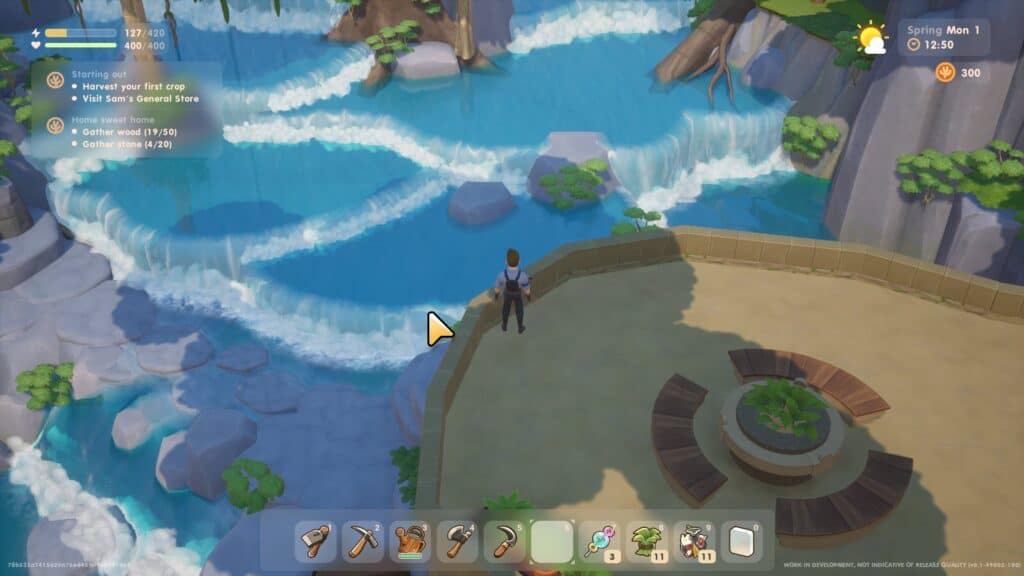
Coral Island Beginner’s Guide
Right away I was excited when Coral Island was announced on Kickstarter and backed the project immediately. I was disappointed when they announced at one point there would be a 6 month delay, but encouraged by the fact that they would rather take another half a year to develop the game right than put out a product they weren’t proud of – even in pre-alpha release.
If you’ve played farm-sims you understand what scythes, hoes, mining picks, and watering cans do. The mechanics are surprisingly smooth, crafting allows you to set up those all important storage chests early, and yes, you can pay to expand your backpack.
Coral Island Tip #1: Set Your Time To Go Slow
This was a big tip that also was one of the most important My Time at Portia tips for beginning players, as well! In the settings screen you can set your daily time.
You can set it as low as 50% speed, giving you a lot more time to explore throughout the day. I like having some sense of urgency so I set mine at 70% and was happy with that, even though there are some days that even that has me rushing home without talking to as many villagers as I wanted to visit.
The normal 100% setting gives about 20 minutes in an in-game day…which just isn’t enough. Going down to 50% gives about 40 real world minutes per in-game day, minus menu screens because games where time keeps running when you’re talking or rummaging through your backpack are just stupid.
Especially in the beginning when you are learning the map, set your time to a slow amount and go from there. There’s no lack of things to do, NPCs to talk to, or places to explore and you can always reset the game time speed later.
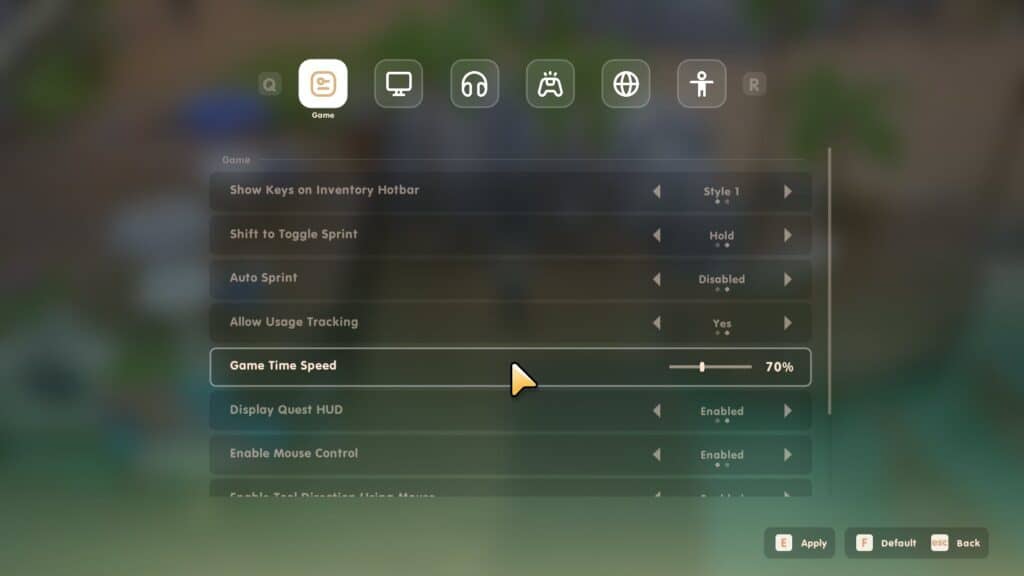
Bonus Coral Island Speed Tips:
And while you’re in there, you should make sure to set your character to Auto Sprint to get around. The map looks small and simple when you hit the M button, but believe me, the world of Coral Island is HUGE and is so much bigger than it looks. There’s a lot to explore – and you’ll need time to do it especially since the incredible detail work and beauty of this game makes it worth exploring and checking out everything in detail.
If you’re playing on keyboard you can hit the space bar to dash and move faster. Since this doesn’t take stamina, feel free to dash around to catch up to NPCs or rush across the map to your next destination and slip in before closing time.
Coral Island Tip #2: Talk to All NPCs
Aside from the obligatory early game quest to meet all the NPCs, Coral Island has a wonderful mechanic where once you’ve met a person, you can see their face (and thus location) on the map screen. If you don’t see them, it means they’re in a building. The same mechanic applies. You can pop into the bar with 10 NPCs, hit the map button, and see who’s there and who isn’t.
This makes it much easier to track down favorite NPCs, those who gave out quests, and to even see question marks when there’s an NPC you haven’t met yet or the arrival of new characters during new seasons.
Talking to all of them early on gives a lot of information and if you love the characters and storylines, you never know which NPC will tell you something about another that opens up other potential interactions.
This is a vibrant and interactive community that feels real – and you’ll want to get connected to that early to get the most out of this wonderful cozy game world.
Coral Island Tip #3: Don’t Throw Away Trash!
Considering how much you get early, you might have assumed trash was important…and you are correct! Trash is actually a very important building block material that is used in a variety of machines to create materials you will need for crafting recipes throughout the game.
Trash is used for many important crafting recipes and almost immediately can be made into scrap using a recycler, and scrap is used for a LOT of crafting recipes in the game.
Trash is used directly as a crafting ingredient for:
- Recycling Machines
- Makeshift Scarecrows (the first ones available)
- Compost (via composter)
- Makeshift Storage Chests (the first available)
- Multiple decorative paths, fences, or gates
Scrap is used as a crafting ingredient for:
- Sprinklers & advanced sprinklers
- Oil press
- Extractors
- Kegs
- Wide array of decorative items & more
So make sure to store the trash in a storage bin. Although this is a resource that is super easy to get 100’s of in the early game – you’ll eventually want to use all of it and more!
Coral Island Tip #4: Grab the Ore Upgrades for Mining First
When it comes to upgrading skills, the mining skills you want to upgrade first are the ones that give more ore. Ore is badly needed to smelt into bars for tool, house, and building upgrades and it is a resource that is in short supply.
The first open section of the mine offers bronze ore in addition to various gems which can be donated to the museum or sold for very good early game profit. Getting to the bottom of one mine section opens up new mines and new types of ore.
Bonus Tip: Upgrade Your Pick Axe First! While you might be tempted to upgrade your axe first, and that’s not a bad upgrade, the mining is currently the grindiest part of this game and the valuable ore is not as plentiful in Coral Island as it is in Stardew Valley. Upgrade your mining pick first so you can get through the mines faster, allowing you to acquire more ore and open up more mine tunnels.
Related Article: Which Tool Should I Upgrade First in Stardew Valley?
Coral Island Tip #5: Don’t Ignore Dig Spots
I’m embarrassed at how long it took me to realize that the oddly bland flowers that sprouted up in many different places weren’t just a weird aesthetic background choice, but actual dig spots. Like the “roots” in Stardew Valley (though they always looked like worms to me) that told you where to dig to find something special, the flowers like the one in the screenshot below indicate where you want to use your hoe to find something special in Coral Island.
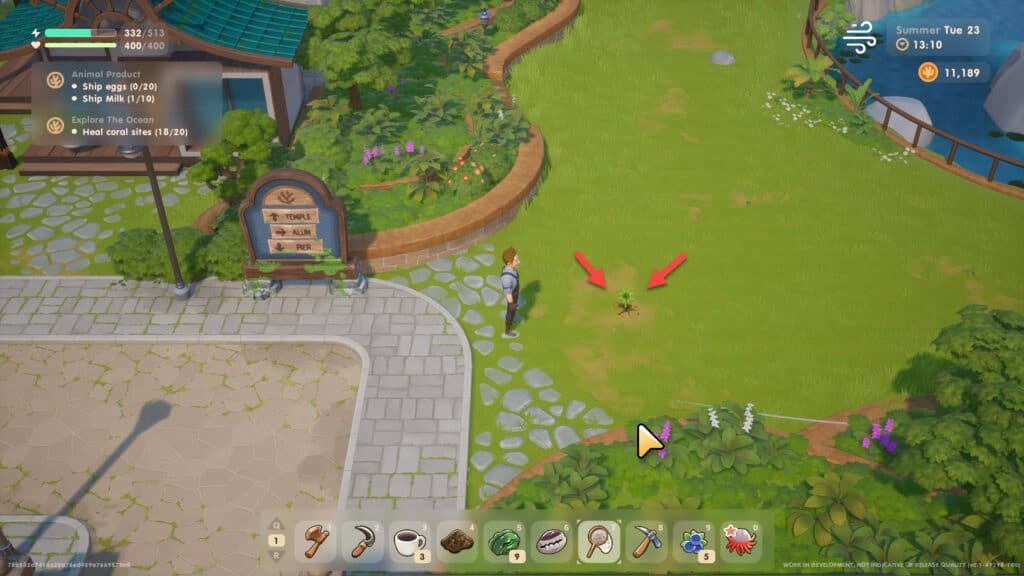
These could be mixed seeds, forgeable items, artifacts, and more, so it’s definitely worth breaking out your hoe every time you run into one of these to see what surprise lays under the surface of the ground!
Coral Island Tip #6: Remember to Hit X When Scuba Diving
One of the neatest parts of Coral Island that makes it really stick out from Stardew Valley, My Time at Portia, Graveyard Keeper, and all the other similar games in the genre is the Scuba Diving that is attached to cleaning up and fixing the oil spill underwater. This is drastically different and brings something neat and new to the table.
However, it can be easy to wander off and find yourself running out of time and energy then wasting already precious time trying to find your way back.
Just hit the X button on your keyboard, or the equivalent button on future releases on consoles, and after a few moments the anchor will appear wherever you are on the underwater map. This will also be where you get dropped back off when you dive underwater once again, letting you pick up right where you left off!
One thing that becomes more apparent the longer you play Coral Island: the designers have put a ton of thought into quality of life.
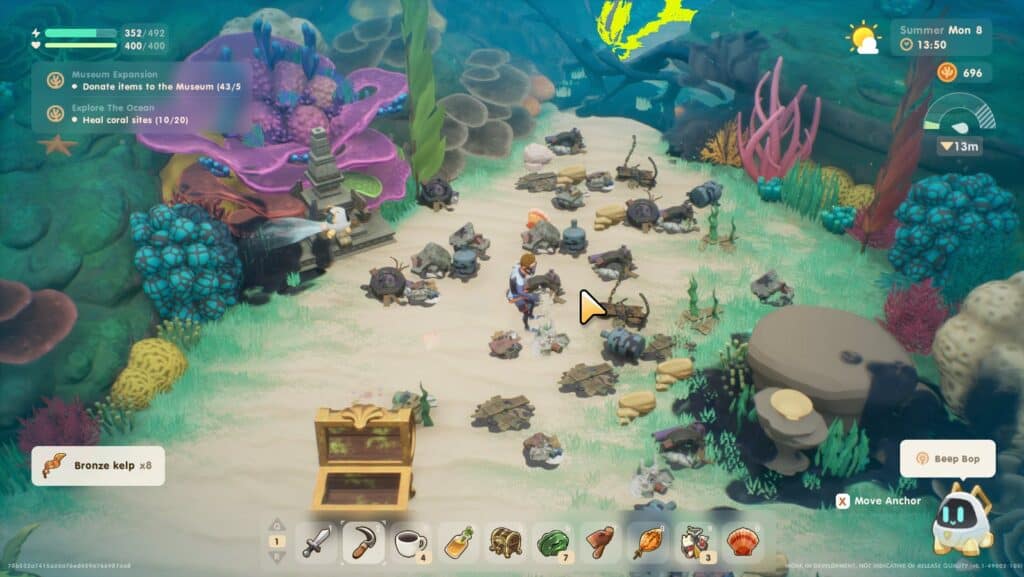
Coral Island Tip #7: Upgrade the Backpack Fast!
This is an no-brainer with any farm-sim cozy game whether it’s My Time at Portia, Stardew Valley, or any of the dozens of variations and knock-offs out there. This is especially important in Coral Island as it is more challenging to get a large of money built up in the beginning than in many similar games in the genre, and being able to cram a backpack full of everything when out and about definitely helps.
The backpack upgrades are also very reasonably priced, making this early upgrade a no-brainer.
Coral Island Tip #8: Don’t Panic At Giant Turtles
My first major roadblock game from scuba diving and running into a giant turtle who decided he wasn’t moving to let me clean the filthy filthy polluted ocean behind him until I gave up a bronze quality cucumber. Which was a problem since it was too late in the season for me to make one.
Don’t Panic!
While my initial annoyance was understandable, there is some good news: the demands change based on season.
So once it was summer, he wanted a bronze level tomato instead, and I had the entire season to make sure I could provide it. Again, a great quality of life improvement so if your first run into a giant turtle blocking your way don’t get frustrated at the idea of being blocked out for three full seasons, because that’s not going to happen.
Just make sure to have some fertilizer and money for seeds on hand when the season changes and you’ll have plenty of time to grow the bribe needed to get past the giant turtles keeping you from the next section of ocean floor to clean and explore.
Coral Island Tip #9: Blueberries Make Great Gifts
Blueberries grow in giant numbers, almost all the townspeople like or love them, and you can grow enough to gift people and still build a keg or two to create some serious money at the same time.
Since these crops produce berries every few days after the first spawn you’ll be getting gifts and cashable crops all summer long, which gives you everything you need to advance relationships with the villagers without sacrificing badly needed funds to improve your farm.
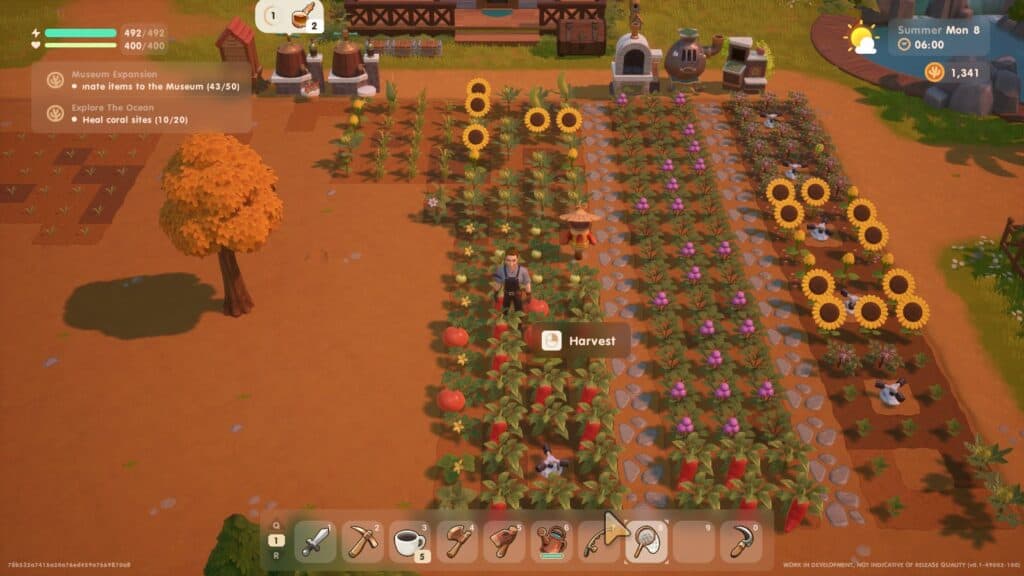
Coral Island Tip #10: Unlocking Fast Travel
Part of the reason to follow the game’s cues to learn all the mechanics and do different things is that fast travel is unlocked one spot at a time depending on meeting certain benchmarks. The fast travel to the mine only opens once you’ve reached a certain depth. The fast travel to the Lake Shrine only works after collecting offerings begins.
Diving, farming, meeting people, and advancing certain plot lines all open up other fast travel spots which makes it that much easier to move around the map throughout the day and considering how surprisingly big this map is – that’s a big deal.
Coral Island Tip #11: Take Advantage of the Hot Springs
The Hot Springs aren’t open at the beginning of the game, but they open up after you finish the second bundle of offerings at the Lake Temple, which is quite easy to do by early summer.
Once that 2nd bundle of offerings is finished, the Hot Springs are free to use and fire up about 3 energy per second. If you have the in-game time set to 50%-70% that means you can recharge all your energy after only a couple hours and get back after those chores once again.
All for free – which is a pretty sweet deal.
Coral Island Tip #12: Search for Crashed Satellites When There’s A “Boom In The Night”
Sometimes you’ll hear a boom in the night, and when you get that message it’s worth running around the farm to see if you can locate some space wreckage. Breaking these down with an axe provide a large number of scrap and batteries – which you cannot seem to acquire anywhere else, especially in the early game.
This is a good way to get good crafting materials early, as well as some late ones for later in the game. So enjoy when you have some gifts falling from outer space.

Coral Island Tip #13: Don’t Sleep on Honey Bees
The idea that Artisan goods are worth more than the base parts makes sense and isn’t anything new for players who love the farm-sim genres, but the difference in income between flowers grown or foraged, and the honey made from them, is MASSIVE. It’s far more than what you get from juicing stuff via kegs, and since the bee hives can process up to three flowers at a time, you can really get the honey farm going.
The crafting recipe for bee hives comes after leveling up to level 2 for catching, which is why you shouldn’t blow off the bug catching early game (learn from my first game mistakes, young gamer).
I have frequently seen the honey sell for 5, 7, or even 10 times the value of the flower it was made out of so if you want to help make sure you have a steady supply of income build a few bee hives and after selling one of each flower (my OCD tendencies won’t let me not sell one of everything at least once) put the rest in a storage bin to keep those hives full and humming…or buzzing.
Bee hives work with both grown/farmed flower crops as well as those foraged in each season.

Coral Island Tip #14: Machines Often Queue 3+ Per Build
If you’re used to other farm sims you’re used to the 1:1 ratio of needing one machine to process one raw material into something else. Most of the machines that process artisan crops like flowers to honey or fruits/veggies into juice will take 3 at a time – meaning you don’t need nearly as many kegs or bee hives to mass produce artisan goods.
Other machines also take more than a 1:1 as the Recycler can help create up to 20 scrap at a time, while furnaces can smelt up to 5 metal bars at a time.
So my recommendation is to build and test out one crafted machine before spending your resources building machines you actually don’t need because of each machine’s ability to mass produce.
Coral Island Tip #15: Become The Summer Coconut King (or Queen)
Coconuts grow on the palm trees over spring and/or summer, and once they’re ripe, you can kick the trees and gather up three per tree. Two runs will give you dozens and dozens of coconuts which can be sold for money, eaten for around 16-20 energy each, or if you have an expanded house and Chef’s Knife you can turn every coconut into a coconut drink which gives you 40+ stamina per.
So to borrow a line from one of my favorite early Let’s Play Videos of Spirit of the Island on YouTube, take the attitude of “I Am The Coconut King!”
So make sure to collect all the coconuts you can and use them to increase your energy and get foraging, chopping trees, collecting fiber, or doing one of the many many tasks you’re going to have early game when energy is at an absolute premium.
Coral Island Beginner’s Tip from Our Favorite Coral Island YouTuber!
Coral Island Review: In Conclusion
Coral Island is one of the very few serious challengers to Stardew Valley for the top pantheon of farm-sim cozy games, and even in just the early days of release it has become obvious that Coral Island is going to be a stunning game and potentially one of the best farm-sim or cozy games made to this point – and one of the very few serious challengers to the upper pantheon of the genre that generally includes Stardew Valley, My Time at Portia, Graveyard Keeper, your favorite Story of Seasons, and not much else.
These excellent Coral Island tips and tricks will give you the knowledge and advice you need to make sure your island paradise farm starts off on the right foot for a gaming experience you’ll adore!
Other Video Games You May Love
- Can You Lose Hearts in Stardew Valley?
- Is Sakuna of Rice and Ruin Worth It?
- Can You Use Stardew Valley Music in YouTube Videos
- How Much Health Can You Have in Terraria?
- Can You Change Time in Terraria?

Proud to embrace the locally created moniker of “Corrupt Overlord” from one of the all time great Lords of Waterdeep runs, Shane is one member of the Assorted Meeples crew and will be hard at work creating awesome content for the website. He is a long-time player of board games, one time semi-professional poker player, and tends to run to the quirky or RPG side of things when it comes to playing video games. He loves tabletop roleplaying systems like Dungeons & Dragons, Pathfinder, Werewolf, Fate, and others, and not only has been a player but has run games as DM for years. You can find his other work in publications like Level Skip or Hobby Lark.
